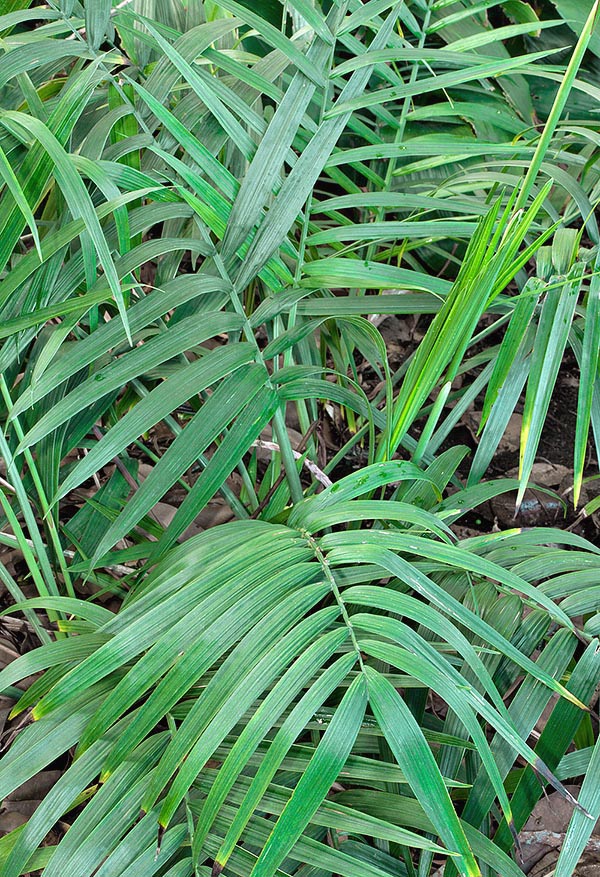Family : Arecaceae

Text © Pietro Puccio

English translation by Mario Beltramini
The species is native to Mexico (Hidalgo, Nuevo León, San Luis Potosí and Tamaulipas) where it grows in the underwood of the forests of oaks, often on calcareous soils, between 200 and 1600 m of altitude.
The name of the genus is the combination of the Greek “χαμαί” (chamai) = on the ground, on the soil, and of the substantive “δωρέα” (doréa) = gift, the German botanist Carl Ludwig Willdenow (1765-1812), who created the genus in 1806, did not specify the exact meaning of the name. The name of the species is the Latin adjective “radicalis” = radical, with possible reference to the acaulescent posture of the first specimen described.
Common names: Mexican parlor palm, radicalis palm (English); palmilla (Mexico).

Native to Mexico, the Chamaedorea radicalis may reach 4 m of height and the elegant cut leaves, exported for floral compositions, are the main source of income for many local populations. It shows good resistance to cold and fits well, in pot, for the decoration of inner spaces, even if little luminous © Giuseppe Mazza
Leaves, on a 12-30 cm long petiole, pinnate, 0,6-0,8 m long, with 12-20 linear lanceolate leaflets with pointed apex, alternate, opposite or sub-opposite, regularly arranged on both sides of the rachis, 22-35 cm long and 1,5-3,5 cm broad, rather coriaceous, of dark green colour or dark green with bluish reflections. Foliar base, on the specimens with stem, 20-30 cm long, open on the side opposite to the petiole for about half of the length, of pale green colour, coriaceous, persistent dry for long time. Inflorescences, on an up to 1,2 m long green peduncle, among the leaves (interfoliar), erect, ramified, the male ones with flowers in groups of 2-5 at the base of the rachillae, solitary at the apex, of about 3 mm of diameter, of green colour, the female ones with solitary flowers spirally arranged, of about 3 mm of diameter, of green colour. Globose-ellipsoid fruits, about 1,2 cm long and of about 0,9 cm of diameter, initially of green colour, then orange yellow and finally red when ripe.
It reproduces by seed, in draining loam maintained humid at the temperature of 24-26 °C, with germination times rather variable starting from 1-2 months.
Vigorous species and undemanding that the different typology of posture (acaulescent or with stem) and of colour of the leaves renders particularly versatile, as single specimen or in group, in the realization of parks and gardens, even if of small dimensions. Cultivable in the tropical, subtropical and temperate-warm zones, where it can resist without damages to temperatures up to about -7 °C, some grade lower with damage to the leaves, proving therefore to stand among the most resistant of the genus, perhaps even the most resistant, to the low temperatures. Furthermore, it can stand the just filtered sun as well as the shade, is not particular concerning the soil and well rooted can stand relatively long drought periods, but grows best in the draining, fertile, ones, maintained constantly humid. It well adapts to the cultivation in pot for the decoration of inner spaces even if little luminous, being one of the palms not needing particular cares, in draining, fertile loam, with regular and abundant waterings in summer, but without stagnations, spaced in winter, allowing the substratum to partially dry up before giving water again. Useful are the fertilizations, in spring-summer, with products suitable for green plants in pot. The cut leaves are exported for floral compositions, their collection represents the main source of income for many inhabitants of the origin zone, but may cause, if indiscriminate, the reduction in the time of its presence in nature, it is therefore to be properly regulated in order to get a sustainable management.
Synonyms: Chamaedorea pringlei S.Watson (1891); Nunnezharia radicalis (Mart.) Kuntze (1891).
→ For general notions about ARECACEAE please click here.
